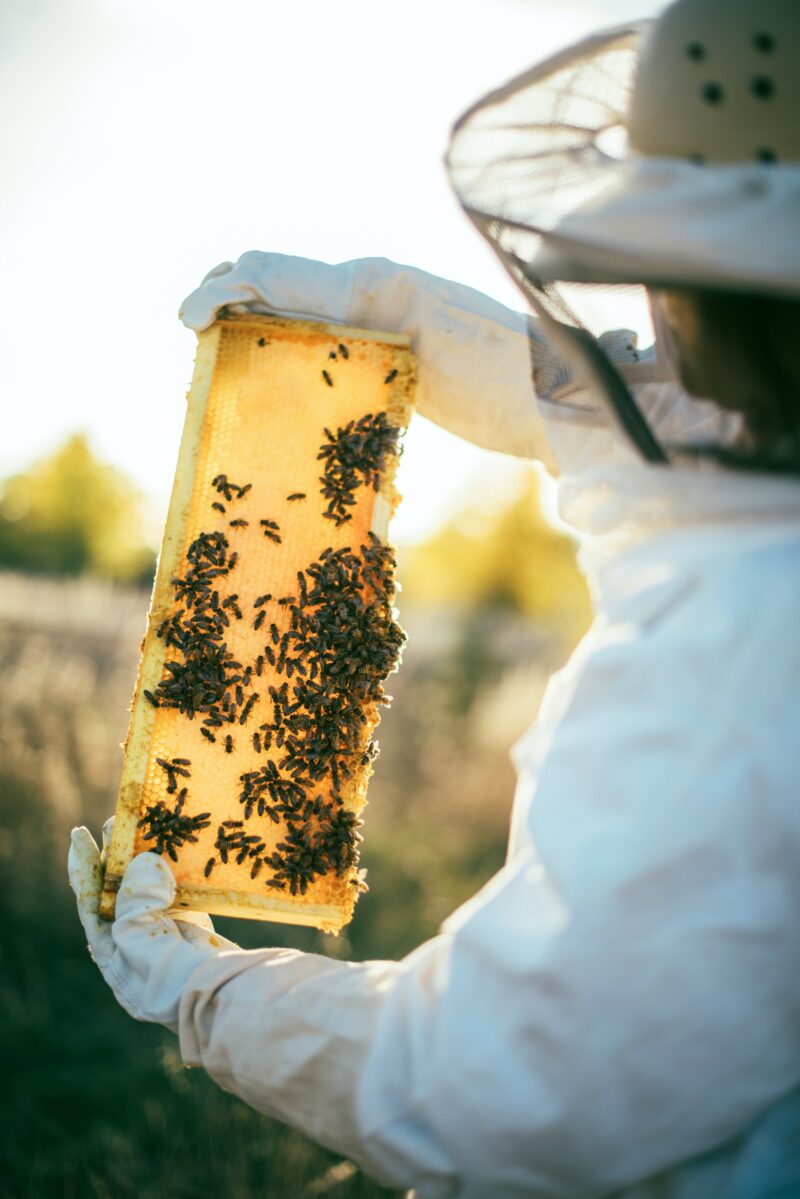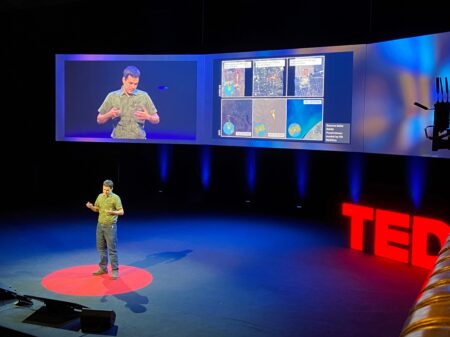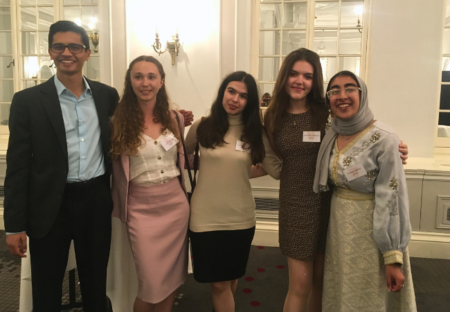Honeybees occupy the dizzying heights of the most advanced societies on earth. A honeybee colony is a complex eusocial society, with one queen, thousands of her sterile, female progeny, and a few hundred of her sons (drones).
As predicted by the models of Bill Hamilton developed in the 1960s Department of Zoology at the University of Oxford, the eusocial organisation persists because of the haplo-diploid organization of genetic inheritance of the insect order, the Hymenoptera. The sterile workers create the wax comb, rear the brood (larvae), feed the queen, guard and clean the nest, and collect all the food. Honeybees visit flowers to collect floral nectar and pollen which they use as their sole sources of food. Nectar is their source of carbohydrates and pollen is their main source of protein, fat, and micronutrients. This mutualism between plants and bee pollinators originated over 100 million years ago and is one of the key causes of the diversification of the Angiosperms.
Humans have benefited from and depended on the work of honeybees for millennia. Many ancient civilizations revered bees for their valuable production of honey and wax; bees were often associated with royalty and used as motifs of rulers or deities. Domestication of honeybee began as early as the ancient Egyptians who used clay tubes to keep bee colonies and harvest honey. Honey is a key food source for human societies as early as hunter-gatherers who tracked honeybees to their nests to plunder them for honey and bee grubs. The global annual value of honey production is estimated to be ~£5.6 billion, and many products that originate from honeybee colonies, including royal jelly and propolis, are sold throughout the world for use in beauty and health industries.
Many ancient civilizations revered bees for their valuable production of honey and wax
Bees also contribute to food production in modern agro-ecosystems. Many of the fruit and nut crops we consume in our daily lives depend on domesticated honeybees for pollination. Agricultural economists estimate that ~35% of the crops we either require or are enhanced by the visits of pollinating insects. Almonds are an example of a crop that requires pollinators to set fruit. California is the world’s largest almond producer, with a crop that is worth ~$7 billion p.a.. Each year, millions of honeybee colonies from all over the United States are taken to California to pollinate almond trees while they are in flower in February. Many other fruit, nut, and vegetable crops are enhanced by the visits of bees. Soft fruits like strawberries and blueberries can double their yield of fruit when pollinators are introduced during flowering. The demand for pollination is growing alongside ever increasing markets for fruits and vegetables as part of human diet.
Intensification of land use has reduced flowering plant diversity and abundance, resulting in poor or insufficient nectar and pollen for honeybees, especially in agricultural landscapes where plant diversity is low. Modern agriculture also employs a staggering array of synthetic chemicals to combat insect pests, fungi, and weeds. These chemicals are used on almost all the foods we eat, including the flowering plants that produce fruit when pollinated by bees. Research in the past 15 years has shown unequivocally that these compounds have devastating consequences for honeybees and for the wild bee species that also contribute to pollination services. In addition, the spread of the ectoparastic mite, Varroa destructor, from Asia throughout the rest of the world (except Australia) has had drastic consequences for honeybee colonies. The Varroa mite is a vector for many viruses including the deformed wing virus that reduces the immunity of bees and renders newly emerged adults useless to the colony as foragers. We have few weapons against the mite because they quickly develop resistance to the few chemicals that can be used to reduce their populations in bee colonies.


A Hertford College alumnus (matriculated in 1994), Professor Geraldine Wright arrived back in Hertford College and the Department of Zoology in Oxford in the autumn of 2018 to set up a research laboratory devoted to studying how bees learn about, select, and consume the appropriate nutrients they require. In conjunction with her collaborators in Israel and at the Royal Botanic Gardens (Kew), her lab has developed methods for measuring how whole bee colonies regulate their intake of essential nutrients including protein, fats, and carbohydrates. These methods include the use of standardized rearing cages in controlled conditions in incubators, semi-field conditions where bees are limited to flying within an enclosed space, and field conditions as in a professional apiary. Through over 10 years of BBSRC funding, she and her collaborators have identified the nutritional optima of adult worker honeybees. Using the information gleaned from these experiments, she and her collaborators have successfully created a livestock feed for bees (i.e. a pollen substitute) that will be marketed to beekeepers worldwide through a new University spin out company. Future research will include investigations into the honeybee ‘lipidome’ to understand how lipids in diet are converted into fats used for energy storage, membranes, fecundity and immune function in bees.
Wright’s lab also studies the bee’s sense of taste and its ability to learn and remember floral cues associated with food. We have found that bees cannot detect toxic pesticides (i.e. neonicotinoids) in the nectar of plants such as oilseed rape that have been sprayed or treated with these compounds. Bees may not possess gustatory mechanisms that enable them to detect bitter/toxic compounds. Instead, her lab’s research indicates that bees appear to have enhanced abilities to detect sugars in foods. Some of her lab’s notable research has shown that certain compounds found in nectar with pharmacological targets in the bee’s brain, such as caffeine or nicotine, amplify the rewarding properties of nectar in the memories of bees. Plants like coffee and citrus have nectar laces with quantities of caffeine that are comparable to a cup of coffee (on a per unit basis). Wright’s lab found that bees that consume caffeine-laced nectar are more likely to learn and remember the floral traits (e.g. scents) associated with this nectar. The bees cannot taste the caffeine in nectar. Instead, they unwittingly consume the nectar but believe it has greater value than nectar from other plants. This leads them to be more likely to visit other flowers of the caffeinated plant species, enhancing its fitness through outcrossing. In recent research, members of her lab have identified that if bees are exposed to compounds like caffeine or nicotine for several days, they begin to exhibit drug-seeking behaviour associated with withdrawal that are hallmarks of addiction.



